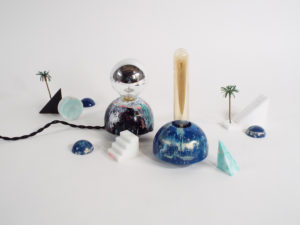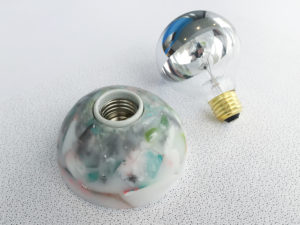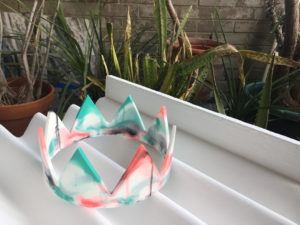Gertler, an enthusiastic and insightful designer, earned his Bachelor of Architectural Studies in 2013 from the University of Waterloo School of Architecture and his Master of Architecture from Princeton University School of Architecture in 2016. Along with Igor Bragado, Gertler co-founded Common Accounts at Princeton in 2014. He was excited by the idea that art and architecture are both using 3D printing to varying degrees, he told me as we sat down during the Be3D event.
Lately, he’s taken advantage of technology available nearby, turning to the equipment at Ryerson University‘s Design Fabrication Zone. Gertler noted that he’s most recently been using the Form 2 available in the DFZ, which is located just two workstations away from Ryerson graduate and businesswoman Stephania Stefanakou‘s workhorse LulzBot TAZ 6.“I engage the most in art practice and in design,” he said, “in the manufacturing of art objects, one-of-a-kind cast design objects. I’ll often use printing as a means of producing molds or negatives in which to cast resin.”
“What you can do with the Form 2 is beyond what you can do with just resin. I’m super happy with what we’ve found here,” Gertler told me of the resin-based 3D printer.
“I first used the first Formlabs printer in 2014 for a pavilion, working with a Toronto architecture office that was working as the curator for the Canadian pavilion at the Venice Architecture Biennial, there we were using it more conventionally for an architect, producing architectural scale models. We also ran into the challenges of working with a very new technology. I haven’t encountered any of those issues with the new generation of the technology that’s available at Ryerson. Other artists come through my studio and can’t believe that resolution comes off a 3D printer, they remember what came off a 3D printer when they were in art school.”
- [Images provided by Miles Gertler]
As developments in desktop 3D printing continue to advance, we’re seeing young graduates afforded potential in design that is indeed unbelievable to those familiar with earlier-generation capabilities. Gertler’s approach to the technology showcases its potential through a variety of means, and he is always looking to expand on what is possible as new advances are made.
“The next thing I’d like to see is with the resin available, like a brighter white, or a clearer clear, with color tones, which mean so much for a finished object,” he said.
The good news for him here is that Formlabs is regularly introducing new resins to the market, as well as releasing details about the colors of materials they offer. As the materials available continue to widen, artists like Gertler will be equipped with a broader palette with which to work. Some of Gertler’s work explores the artistic philosophies of form and function, familiar and unfamiliar, useful and art.
Among Gertler’s projects in this hazy area are wall-mounted hooks, which, he said, “can produce a scenario for a gallery or an art collector with designed slack rope — and same time, you can imagine it in your home or office as a functional item; it can be 3D printed full scale in resin, casting in silicone.”“I am working on objects that have a larger market function, and in the crossover between art practice which is mostly in digital collage/printmaking — working with scenarios which are populated with objects that constitute an image/idea of daily life, things that are sort of familiar and unfamiliar at the same time. Using hooks, 3D printing, casting of new objects to translate image-based scenarios into more material representations,” he explained.
“There’s a hazy bit: is it a design object or something that you can buy in a shop, something that only appears in a gallery?”
The key to many of the designs lies in differentiation and the removal of expectations and assumptions in what are ultimately pieces of art.
“I am making some totemic items unburdened by the expectations of function — collectible art objects,” Gertler told me. “These boundaries are blurred more and more these days, and that allows me to take an object that can be infinitely reproducible to produce a mold, allows me to create a one-of-a-kind object from that, pigments will always be different. These objects can cannibalize earlier objects, integrate its own waste into production, earlier casts that aren’t desirable anymore or have outlived their usefulness. Some are more functional than others, like lamps, while others are more totemic for interior scenarios.”
Lately, Gertler has been focusing artistic attentions on projects centered around these hooks and a series of crowns. For the crowns, he 3D prints molds in four parts, though he notes that eventually he could cast from the joined quarters to create one full mold. Among other projects in his queue are some “that will also engage in an increase in scale” as the projects “all tie into architectural ambitions of these images.”
- [Images provided by Miles Gertler]
“As an architect you’re filled with the idea of scaling up,” he noted.
On the architectural side, Gertler has been involved in several international projects, including in Istanbul and Seoul. At the Istanbul Design Biennial in October, Gertler participated in two exhibits with his architectural office; the first was a 3D printed object to fit into the biennial’s theme (“Are We Human? Design of the Species”), in which, he noted, any act of design is an act of the body, every theory of design has been accompanied by the design of the human. He also explored projects around death and human remains, and produced a model of Bio-Response Solutions‘ technology focusing on an ecological alternative to burial/cremation that liquefies the body into a super-fertile alkaline solution. The model was created using the Form 2, in several parts.
In Seoul, Gertler worked on an installation focusing on urbanism in Gangnam’s plastic surgery district. The area, made especially famous through a surprise global hit song, is well known for an extreme focus on aesthetics and status. This project documented the unaccounted-for plastic surgeons within Gangnam, and explored the trauma done on the human body during surgical procedures, as well as the infrastructure of the neighborhood.“We felt like tinkerers or toy makers,” Gertler said of this project. “It was all done with moving parts to replicate the actual tipping of the machine.”
“It’s extending the definition of what it is to be a plastic surgeon,” he explained. “Rendering occupants fluid in terms of visual and physiognomic identity and in terms of their actual body, you swell after the physical trauma of plastic surgery. We used 3D printing to account for all of those different technological infrastructures within the district. We modeled the array of prosthetic technology into which the subject plugs in in the first 24 hours of their recovery in a recovery room in one of these clinics — hospital bed, pillows, medical masks, the whole apparatus. We also used printing also to account for all of these appliances, there’s an appliance for everything, for every pain or pleasure. It’s in line with plastic surgery as part of medical tourism in Korea now. Counteraction to the violence of surgery.”
These are the two biggest projects Gertler has engaged in using 3D printing on the architectural side, and he explained that, “it’s become a pretty central part in this design and art practice going from 3D model to the finished resin object. It’s pretty immediate.”
To see more of Miles Gertler’s work, you can check his Instagram accounts @milesgertler and @commonaccounts, and follow his work as showcased at the Corkin Gallery.
Subscribe to Our Email Newsletter
Stay up-to-date on all the latest news from the 3D printing industry and receive information and offers from third party vendors.
You May Also Like
Profiling a Construction 3D Printing Pioneer: US Army Corps of Engineers’ Megan Kreiger
The world of construction 3D printing is still so new that the true experts can probably be counted on two hands. Among them is Megan Kreiger, Portfolio Manager of Additive...
US Army Corps of Engineers Taps Lincoln Electric & Eaton for Largest 3D Printed US Civil Works Part
The Soo Locks sit on the US-Canadian border, enabling maritime travel between Lake Superior and Lake Huron, from which ships can reach the rest of the Great Lakes. Crafts carrying...
Construction 3D Printing CEO Reflects on Being Female in Construction
Natalie Wadley, CEO of ChangeMaker3D, could hear the words of her daughter sitting next to her resounding in her head. “Mum, MUM, you’ve won!” Wadley had just won the prestigious...
1Print to Commercialize 3D Printed Coastal Resilience Solutions
1Print, a company that specializes in deploying additive construction (AC) for infrastructure projects, has entered an agreement with the University of Miami (UM) to accelerate commercialization of the SEAHIVE shoreline...








































